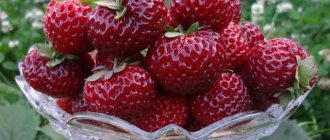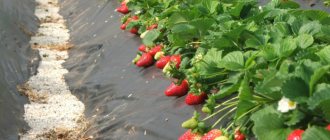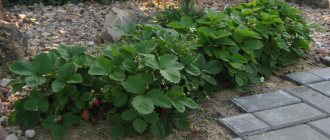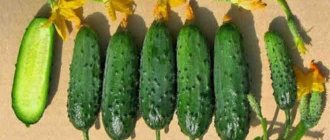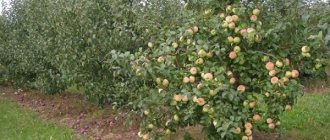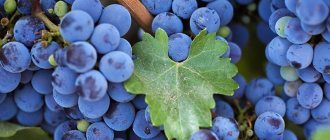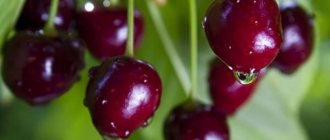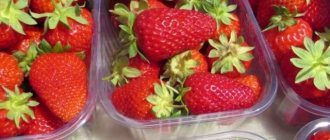How is it different from the usual one?
The most striking differences between these strawberries and ordinary ones are:
- the way it grows is curly, thanks to the numerous whiskers that it produces;
- possibility of use for decorative purposes (even in an apartment);
- low cost of hanging seedlings;
- berries on a vertical support are easier to protect from attacks by rodents and hedgehogs;
- adaptability to weather conditions of middle and southern latitudes.
Important! Climbing strawberries like vines do not exist in nature. This is a rather cunning trick of scammers, on a par with blue roses. However, a similar effect does occur. It is achieved due to the “ampility” of the varieties - the abundant growth of fruiting bushes on a par with the mustache bushes. With proper care you can get a climbing bush, but it is better not to expect a harvest lasting from spring to autumn.
Are climbing garden strawberries a myth?
It takes your breath away when you see in bright photos magnificent cascades of green shoots strewn with red berries. The summer resident's heart beats faster. I immediately want to buy seedlings and plant this “miracle” in my garden. What a disappointment it is when you find out that the climbing strawberry is a myth and this species does not exist in nature.
But what about the photographs, is it really photoshop and successful editing? So, in the Rosaceae family, of which the garden strawberry (strawberry, Victoria) is a representative, there are no vines, so calling some types of crops climbing is incorrect from a biological point of view.
But ampelous varieties have been bred, distinguished by the presence of long mustaches with fruiting rosettes. Unlike ordinary species, these plants produce berries both on peduncles and on tendrils (without contact of the latter with the soil).
Planted in hanging baskets, flowerpots, or on any elevation, the bushes produce garlands of mustaches. It seems that the plant is climbing, although the long shoots simply hang down.
On a note! Unlike any other types of climbing plants, in ampelous varieties of strawberries the shoots do not grow upward, but only hang down.
It is these hanging varieties that delight gardeners, and inexperienced summer residents consider them a climbing crop. But if you are not picky in the use of terms, then in part such strawberries fit the description of varieties of climbing plants, and even those who are just getting acquainted with the basics of gardening can grow them.
Planting climbing bunch strawberries
Landing includes classic requirements:
- well-lit place;
- drained soil;
- not waterlogged, fertilized soil;
- planting period - from mid-spring to late summer;
- healthy strawberry seedlings.
But for “vertically” growing varieties, the same beds are needed, so you need to:
- Pour gravel or crushed stone into the bottom with a volume of at least 1-1.5 liters and up to 15 cm.
- Sprinkle planting soil on top, fed with manure, compost and sod.
- Water the resulting bed and, after the soil has settled, fill it to the top.
- Plant the bushes 10-15 cm apart from each other, if the bed allows this.
Peculiarity! Since there will not be much land for roots, you need to take proper care of its quality. It would be better to use specialized soil. It is already filled with useful substances and does not need frequent feeding.
Which varieties to choose?
There are many varieties of hanging strawberries, but the most adapted to our climate are:
- Eros is a foreign variety of strawberry that is resistant to cold;
- Queen Elizabeth (I and II) - local varieties, fairly inexpensive;
- Moscow Delicacy - bears fruit until autumn;
- Geneva - unpretentious in care, resistant to frost;
- Ampelous remontant - bearing fruit several times in one season;
- Honey - produces sweet and bright red berries;
- Ostara is a high-yielding variety;
- Alba is an early strawberry that is resistant to cold.
Regardless of the variety chosen, caring for strawberries should be timely and systematic. Desolation and abundance of weeds can destroy even the most resistant specimens.
Vertical placement
Vertical placement can be achieved in several ways:
- Vertical bed. For this, several tires or boxes of different diameters are used. They are installed one on top of the other. Whiskers descend from the upper tier, forming rosettes in the lower ones. It turns out to be a kind of waterfall from strawberry bushes.
- Vases. These are tall vases from which tendrils of berries will hang down beautifully.
- Hanging pots. One of the most beautiful ways. Pots can be hung in a row over aisles to form an arch.
When choosing the location of the seedlings, you should remember that you cannot use small containers - the minimum volume is 1-1.5 liters and a diameter of up to 30 cm per seedling. Otherwise, the roots will be crowded and the plant will quickly die from lack of nutrients and moisture.
Growing in bags
This original method is used for several reasons:
- no weeds;
- easy harvesting;
- preservation of berries from rotting and rodents due to the “suspended” state;
- Possibility of year-round cultivation indoors;
- avoiding stagnation of moisture - it easily flows out of the bags.
The essence of this method is that:
- A hanging bag is selected - often used for sugar or flour.
- The bag is filled with fertilized soil or special soil for strawberry varieties.
- Horizontal cuts are made along the vertical side of the bag.
- Strawberry seedlings are placed in the resulting holes, maintaining the space between them.
- At the end of the planting activities, the bags are hung and thin hoses for watering are connected to them.
Attention! Watering of such a planting system is organized using a separate tank with nutrients diluted with water. From there, the liquid enters the bags through hoses. This mechanism is necessary because it is impossible to fertilize each bush due to the closed type of planting.
Features of culture
Climbing garden strawberries (with long tendrils) belong to the remontant group, characterized by long-term fruiting.
Harvest dates depend on the variety:
- “waves” - 2-3 times a season (for example, at the beginning and end of summer);
- continuously, but with short periods of rest.
Most of them are day-neutral plants, so buds are formed constantly. Due to intensive long-term fruiting, plants quickly “burn out” their potential and require constant rejuvenation.
The bushes are compact, with a large number of leaves and peduncles. The degree of adaptation varies. Some varieties have more shoots, others have few. The length of the whiskers is from 35 to 100 cm; rosettes are formed on each, which also give rise to a mustache. As a result, a cascade of hanging shoots grows from a small bush, flowering and fruiting at the same time.
Previously, such species were considered ornamental, but the breeding of varieties with high yields by breeders has made hanging strawberries popular among gardeners.
Climbing plants can be conveniently planted on balconies and loggias, in hanging flowerpots, and grown on window sills in city apartments. It is easy to care for, and the harvest is obtained almost all year round. They are also suitable for planting in open ground with the installation of supports for long mustaches nearby.
“Pros” of climbing garden strawberries:
- small plant sizes;
- high yield rates;
- decorativeness;
- disease resistance;
- the ability to save space on the site by planting the crop vertically;
- excellent berry taste;
- repairability;
- duration of fruiting (from early summer to autumn);
- versatility of fruit use.
But when choosing such varieties, do not forget that they must be replanted regularly (once every 2 years), soil moisture must be controlled, and they must be fed in a timely manner. A large harvest is possible only with abundant watering and adequate fertilizing.
Are there ampelous remontant varieties?
An ampelous remontant variety of strawberries implies fruiting several times a season, not only with inflorescences, but also with tendrils. The main advantage of this species is its high productivity.
Among the popular hanging remontant varieties are:
- Moscow delicacy;
- Queen Elizabeth II;
- Honey;
- Geneva.
Interesting! It was on the characteristics of hanging remontant strawberries that the marketing campaign for the “climbing” berry like a vine was built. Despite the unique qualities that surpass the classic look, you should not expect anything supernatural from this variety.
No individual features of the landing have been established, except for ensuring the whiskers free movement, without the formation of knots and crossing. Standard soil preparation, fertilization, and watering should be carried out for strawberries.
Productivity
The yield of climbing strawberries depends entirely on several factors:
- Variety: Queen Elizabeth produces about two kilograms of berries from a large bush over the entire season, Queen Elizabeth II - about 8-9 kilograms per square meter of plantings, Alba - up to two kilograms from one bush, Homemade delicacy - 1.5-2 kilograms.
- Care: a watering schedule must be drawn up, which must be adjusted in dry or wet weather, fertilizing must also be carried out systematically, as well as loosening the soil, cutting off dried leaves or excess tendrils is necessary so that the plant does not waste unnecessary energy, especially during the growth period.
- Treatment: prevention - there are a lot of remedies, including folk ones, that can be used to protect bushes; awareness of common diseases and timely treatment will save not only the infected plant, but also neighboring healthy ones.
Choosing a strawberry seedling
When choosing strawberry seedlings, follow these rules:
- deal only with trusted sellers - nurseries and specialized stores;
- purchase varieties released in your region.
Seedlings for planting are grown independently or purchased - with a closed or open root system.
With open root system
Seedlings with an open root system (ERS) are grown in beds. Its roots are open, so they are often damaged during transportation and transplantation. The survival rate of such planting material is lower than that of analogues sold in containers.
Watch a video about spring planting strawberries with an open root system:
Signs of quality seedlings:
- the bush has 3-5 leaves;
- leaves – strong, elastic, shiny, slightly pubescent;
- leaf color – bright green, without defects;
- developed root system of fibrous type - the roots are light, 8-10 cm in length, strong, without traces of rot;
- thick horns - from 7 mm, soft light green color;
- the growth points of peduncles are developed, without damage.
With closed root system
Seedlings with a closed root system (ZKS) are sold in containers or cassettes. This option guarantees a high survival rate. Seedlings with ZKS are more suitable for autumn planting.
When buying ZKS seedlings, pay attention to the following points:
- Inspect the cups - many sellers, wanting to make money, sell seedlings with OCS as cassettes, planting them a day or two before sale in plastic containers. The authenticity of the PCL is evidenced by the ends of the roots that have grown through the drainage holes.
- Inspect the seedlings. There should be no signs of disease or damage on it.
To get seedlings yourself, tear off the extra flower stalks with rosettes from the mother bushes - leave only the 2 strongest ones. When the tendrils take root, separate the young plants and plant them in containers.
Planting material can also be obtained using the Dutch method - it is called frigo. This technique is used when breeding large-fruited strawberries. Bushes are dug up in the fall, during the initial dormant phase. All leaves are torn off. Bushes devoid of leaves are stored until spring at a temperature from 0 to minus 3 ° C.
Rules for care and watering
Among the rules of care and watering are the following:
- When watering, do not pour water on the leaves and flowers, but rather under the roots;
- It is better not to shade strawberry bushes;
- regularly weed out weeds, because they take moisture, light and nutrients from fertilizers from the crop;
- useless bushes and mustaches that do not bear fruit must be eliminated;
- regular feeding will benefit strawberries;
- in winter, if the plants are outdoors or in a poorly heated room, the bushes should be covered.
Climbing strawberries: propagation
Thanks to the large number of tendrils that are formed, which, in fact, form ampelous varieties of the crop, propagating plants is extremely simple.
Climbing strawberries in the garden
Ampel strawberries - care and cultivation
Proper care involves leaving no more than 5 whiskers on which the sockets are located. The rest must be removed, otherwise the mother plant will rapidly lose its strength and will stop producing fruits and flowers.
The most fruit-bearing rosettes can be marked for yourself and later used for propagation. Reproduction is carried out as follows: the mustache is separated from the mother bush and transplanted into separate pots.
Sowing seeds
To obtain seeds during fruiting, it is recommended to select several large fruits, dry them and collect all the seeds. In spring they can be planted in the soil. It is worth paying attention to the fact that several different varieties of strawberries cannot live side by side. It is especially not recommended to grow hanging and ordinary varieties nearby.
Climbing strawberries in a greenhouse
Another important point is that you should not grow crops from old seedlings. They will no longer bear fruit or grow properly. You should not give preference to too small planting material. It’s better not to save money and buy several dozen high-quality, large and strong bushes that will bear fruit abundantly, and not just take up space and take up time and effort.
Flaws
The disadvantages of the curly species are few:
- comparatively more frequent watering due to the size of the plant;
- difficulties in organizing the placement of mustache rosettes on a vertical surface;
- frequent feeding;
- instability to frost - you cannot cover such a bed before snow falls without damaging it;
- ease of falling into fraudulent resources - offers for vines with kilograms of harvest are common.
Advantages
Some of the benefits of climbing strawberries include:
- aesthetic qualities;
- ease of harvesting;
- ease of weeding;
- space saving - due to the weaving of the mustache upward, it takes up little space on the ground;
- availability of remontant varieties;
- ease of regulation of the direction of growth using numerous whiskers;
- not “afraid” of direct sunlight;
- relative freedom in planting options: in bags, vertical flower beds, flowerpots or hanging pots.
What diseases are you susceptible to?
Strawberries, like any living organism, are susceptible to many diseases. The most common of them:
- ordinary spotting - can appear in different parts of the leaves and affect small areas;
- powdery mildew is a severe fungal disease that affects leaves, flowers and shoots with a white coating, disrupting the growth of fruits and killing the plant, drying it out;
- Strawberry mite - affects leaves and flowers, the strawberry bush quickly dries out, producing less and less fruit until it dies completely.
To combat diseases, both chemicals and biological substances, as well as folk remedies, are used.
Diseases and pests
Climbing strawberries are moderately resistant to both diseases and pests. Most often you can find strawberry mites, nematodes or fungal diseases on it .
- Under the influence of the strawberry mite, the berries become much smaller and gradually wither. You can get rid of such pests using chemicals such as Nero, Fufanon, etc. For the best effect, three treatments are carried out with an interval of 7-10 days;
- When nematodes occur , the berries become tough and the stems become thick and short. In this case, the plant cannot be treated. It will need to be dug up and burned;
- Various types of fungicides are usually used to combat fungal diseases
Strawberry mite
Fungal disease of strawberry leaves
Strawberry nematode
To protect strawberries from various kinds of problems, it is necessary to properly care for them and carry out preventive treatments with Brodka liquid twice a season (spring and autumn).
Climbing strawberries are a very unusual plant , thanks to which you can give a new look to any garden plot or room.
Reviews from gardeners
I ordered expensive climbing strawberry seedlings. The seller advised installing a vertical support as soon as possible, as it will grow quickly. Everything was done according to the rules, however, the usual remontant ampel strawberries grew, like in my garden. Nothing unusual, it grows on its own.
We planted the purchased seedlings in hanging pots above the porch. Of course, it did not curl, but it produced berries even on long hanging mustaches.
My husband built a garden for me in the house (square meters allow). I planted these strawberries in flowerpots. It looks very beautiful, especially when the berries appear. By the way, the taste is quite sweet, but not sugar, of course.
5 / 5 ( 3 voices)
Growing ampelous strawberries
There are many options for planting climbing (ampeloid) strawberries. The most common is growing in flowerpots or pots. Over time, the curly mustache begins to grow and droop down. It looks especially beautiful during the flowering and fruiting period, since the berries even grow on rosettes. The container used can be absolutely any, the main thing is that it is deep enough (at least 30 cm). It should also have holes for water.
The optimal time for planting seedlings in pots is the second half of spring.
An interesting option is to grow climbing strawberries on a trellis. Planting is carried out as follows. The seedlings are planted in the ground, and a trellis or other structure (mesh, wicker fence, etc.) is installed nearby. A grown mustache is tied to it. This method of planting is a good decoration for the site. The height of the structure should not be more than 1 m, the width is arbitrary.
A pyramid-shaped flowerbed is the most common way to grow ampelous strawberries. To make it, make a box 1 x 1 m with a height of at least 30 cm and place it in the ground. Then they make 2 more boxes without a bottom - the first is 20 x 20 cm in size (the same height), the other is 60 x 60 x 60 cm.
Next, the pyramid is assembled. The central box is half filled with clay, then with fertile soil. Subsequent boxes are placed on top and everything is filled with soil. Strawberry rosettes are planted at intervals of 20 cm.
Climbing strawberries (we reviewed the descriptions of the best varieties above) should not be planted too close to each other.
The soil should be soft and fertile. Planting is best done in mid-summer.
The planting mixture may be as follows:
- 30% two-year-old compost;
- 30% meadow turf;
- 25% peat;
- 20% organic manure.
